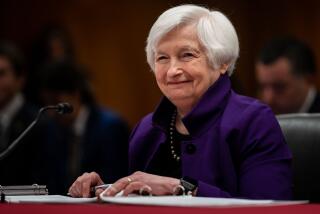Recession May Force Taxpayer Bank Bailout : Finance: Congress is told of a possible depletion of the FDIC fund, which could spark rescue efforts similar to the S&L; crisis.
- Share via
WASHINGTON — A taxpayer bailout of commercial banks similar to the savings and loan rescue may be necessary if the economy slips into a recession, congressional budget experts told Congress today.
“We’re on thin ice, but the pants are still dry,” Congressional Budget Office Director Robert Reischauer told the Senate Banking Committee.
He agreed with an earlier assessment by congressional auditors that the $13.2-billion Federal Deposit Insurance Corp.’s bank insurance fund could face insolvency.
The General Accounting Office, in the darkest assessment yet of the nation’s banking system, said Tuesday that declining real estate values and risky bank loans may necessitate a taxpayer bailout for banks if the economy sours.
“The fund is too thinly capitalized to deal with the potential for bank failures in the event of a recession,” Comptroller General Charles Bowsher said. “Such an event could exhaust the fund and require a taxpayer bailout.”
Asked today if he agreed with that assessment, Reischauer said, “There is a possibility there, yes.”
Even assuming that the economy remains stable, he said, the country can expect 600 to 700 banks to fail over the next four years at a net loss to the government of $5 billion to $6 billion a year unless bank insurance premiums are raised. That would reduce the annual balance of the fund to $4 billion, he said.
Legislation removing caps on how much the FDIC can charge for deposit insurance was introduced today in both the Senate and House by Sen. Donald W. Reigle Jr. (D-Mich.) and Rep. Frank Annunzio (D-Ill.).
Government figures do not yet show a recession, but many economists contend that the economy turned downward when unemployment rose in July and again in August.
With 129 bank failures so far in 1990, FDIC Chairman L. William Seidman has estimated that the insurance fund will incur a net loss of at least $2 billion this year atop losses of $5.1 billion in 1988 and 1989.
Bowsher said the situation is much worse. Including “several billions of dollars in losses” that banks have yet to report, he said, the insurance fund could already be insolvent.
At least 15 of this year’s bank failures have been among the nation’s 200 largest banks.
More to Read
Inside the business of entertainment
The Wide Shot brings you news, analysis and insights on everything from streaming wars to production — and what it all means for the future.
You may occasionally receive promotional content from the Los Angeles Times.










